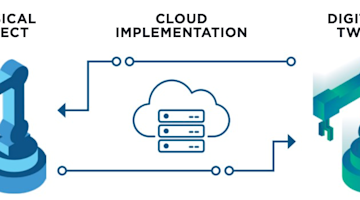The most basic element of any digital manufacturing solution is the data used as input to every decision process in that implementation – from the most basic decisions within a piece of equipment to high-level decisions driving production processes or even overall business strategies. Most shop floor data originates from electronic devices and control systems deployed on pieces of equipment in the manufacturing operation. These data sources are often complemented by any number of different types of information available from sources beyond the shop floor.
We have been integrating electronic control systems on manufacturing equipment for over 60 years. The CNC (computer numerical control) was first introduced in the mid-1950s. The PLC (programmable logic control) was developed in 1968. The first industrial PC was introduced in 1984. While industrial robots were originally developed at the end of the 1950s, the robots that we recognize today evolved throughout the 1970s. These, and other types of electronic devices, can be found on virtually every piece of equipment or process in every manufacturing operation. Additionally, the evolution of sensor technology has further increased the amount of data available from production operations.
This being said, there typically is no lack of data in most facilities. The challenge is efficiently accessing that data and then qualifying the data with a precise meaning so that it can be consistently interpreted by higher-level decision processes. Today, new networking technologies and shop floor communications standards like OPC, MTConnect, and a variety of sensor bus technologies are making access to a broad array of data much more viable than older proprietary solutions once provided.
Two of the more challenging issues faced in the management of manufacturing data are (1) determining which data in an ocean of data is important and (2) what precisely each piece of data means.
A common mistake made in many digital manufacturing implementations is a tendency to want to collect and capture all available data – "just in case we should need it at some point." This typically leads to an overwhelming amount of data, much of which is irrelevant to any decision-making process and becomes a long-term cost for storage and management of that data. A term often applied to this is "data exhaust" – the spewing of data with no relevant value. It is perfectly fine to capture and store large amounts of data as long as every piece of data collected has an intended use.
The often bigger challenge is to determine the meaning of each piece of data collected. Data provided from most sources is given a name by the supplier of the device producing the data. Name and meaning are quite different concepts – there are no standards for naming conventions for data. Each supplier can apply their own definition to the name applied to each piece of data that is produced from their equipment. Therefore, pieces of data with the same name generated from equipment provided by different suppliers may have quite different meanings. When such data is then used in any decision-making process, the outcome generated based on that data may be badly flawed. It is incumbent upon the implementer of any system or decision-making process to validate the precise meaning of each piece of data used as input.
One option to address the problem of similarly named pieces of data having different meanings is to apply a semantic data model to the data. A semantic data model provides a structured meaning for each type of data and also provides additional information regarding how different types of data relate to each other. When using a semantic data model, each piece of data must be interpreted and adjusted to conform to the semantic data model before it is stored or used in any decision-making process – greatly increasing the validity of the results generated from any system or decision process utilizing the data.
In addition to information that can be produced from shop operations, there are a variety of other data sources that already exist in a business that contain readily available information, which can be a valuable source of input to a digital manufacturing system. These data sources include employee databases, MES/ERP systems, engineering databases, etc. Overlooking – or worse, replicating – these resources just because they are not part of the shop operations can be costly – both in efficiency and reliability of maintaining duplicate information.
There are also many online data sources outside of a business that are readily available and can provide valuable information cost-effectively. It is incumbent on solution implementers to creatively assess alternative sources of information to support a digital manufacturing implementation. Some of these online sources include:
Tooling data and specifications
Maintenance procedures and equipment manuals
Material specifications
Environmental information
Let's look at just one example of potential savings that can be achieved by using these online sources.
Let's assume that you want to consider outside air temperature as an input to your HVAC control process. The most traditional solution would be to have a temperature sensor installed on the roof of your plant. This involves finding a temperature sensor that can survive exposure to the environment; mounting an enclosure to house the sensor; and wiring from your roof to wherever your HVAC controller is installed. Then, don't forget about lightning protection, conduit installation, etc. For one simple sensor, the installation costs can be substantial (a couple thousand dollars).
There is a lower-cost alternative. The National Weather Service provides a continuous feed of local temperatures. Accessing this data as an online data source eliminates all the efforts of installing your sensor, and that system is continuously maintained by others at no additional cost to you.
When relying on outside data sources, you should consider the following:
What are the commercial terms associated with accessing each data source?
Are there initial or reoccurring costs associated with each data source?
How reliable are these data sources? Will they always be available?
What is required to transform the external data into a form that works for your business?
The single greatest concern when accessing information from sources outside your business is cybersecurity. Are the connections to the data secure such that they cannot be used as a point of attack from an outside agent, and is that data void of any potential malware that can then propagate through your system?
Data is the foundation upon which your entire digital manufacturing operation exists. While the more interesting portions of any digital manufacturing implementation are the actual systems and decision processes that drive manufacturing operations, it is essential that implementers apply sufficient resources to validate every piece of data used by those processes. You must have clean data, or you end up with "garbage in, garbage out."
You can learn more details about deploying a modular digital manufacturing information system in AMT's “Digital Manufacturing” white paper series, beginning with “Overview of Digital Manufacturing: Data-Enabled Decision-Making.”









